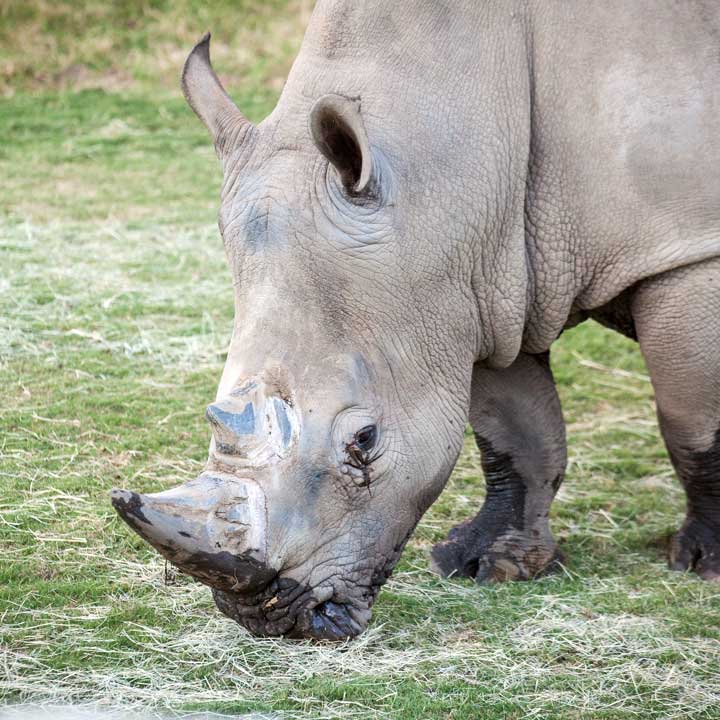

Sudan, the world’s last male northern white rhino, died at age 45 in March 2018. Just two members of the northern species-a 28-year-old female named Najin and her 18-year-old daughter Fatu-remain. In the statement, Barbara Durrant, director of reproductive science at San Diego Zoo Global, says, “Not only are we thankful for a healthy calf, but this birth is significant, as it also represents a critical step in our effort to save the northern white rhino from the brink of extinction.”Īccording to the World Wildlife Fund, northern and southern white rhinos are related but genetically distinct subspecies native to different regions of Africa. One of these females, Amani, is pregnant with her own artificially conceived offspring and is expected to give birth in November or December 2019. Eventually, staff will integrate Edward into the rhino community, introducing him to the five other females housed at the zoo’s Nikita Kahn Rhino Rescue Center. Keepers inseminated Victoria with frozen semen from a male named Maoto last March following hormone-induced ovulation 493 days later, the rhino gave birth after 30 minutes of labor.Īs Natalie Rice reports for the Associated Press, both mother and calf will remain off exhibit for the foreseeable future to ensure they have enough time to bond. Per a press release, the male calf-newly dubbed Edward-is the first southern white rhino to be born through artificial insemination in North America. As follicles grow and some are selected for ovulation, many are lost.A southern white rhino named Victoria gave birth to an artificially conceived calf at the San Diego Zoo Safari Park last Sunday, marking a milestone in the fight to save the closely related northern white rhino from total extinction.Ĭonservation organization San Diego Zoo Global announced the successful delivery earlier this week. Ovaries contain lots of these immature follicles that are just waiting to be activated – in fact, far more follicles than are actually needed. At this point, these contain fluid and secrete hormones which influence the menstrual cycle. The follicle grows over months until it’s ready to ovulate. At the centre of each of these sits an immature egg, also known as an oocyte. So what if we had the means to produce more eggs? While eggs collected from female rhinos are in short supply, generating eggs from ovarian tissue from deceased rhinos could fill the gap.Ĭoral sex: how reproducing species in the lab could be key to restoring reefs in the wildĪs in humans, every female rhinoceros is born with thousands, if not millions, of immature ovarian follicles. As you might imagine, with only two remaining rhinos to gather these precious eggs from, this limits our ability to revive entire populations. After transfer to a surrogate, only some will complete their development and become baby rhinos. Not all of these eggs will fertilise and not all will develop into an embryo. Transferring embryos into surrogates to produce baby animals is a process that’s been well established for lots of species, including horses and cows, though it’s still in the development phase for rhinos.īut the biggest constraint on this approach is that hormonal stimulation of female rhinos produces just a few eggs per cycle. They’re frozen and awaiting implantation in a surrogate female southern white rhinoceros. To date, a handful of northern white rhinoceros embryos have been created this way. After treating the females with hormones the immature eggs were collected, transferred to a lab where they were matured and then fertilised with frozen sperm.

The first breakthroughsĪ team led by Professor Thomas Hildebrandt from the Leibniz Institute for Zoo and Wildlife Research in Germany had a breakthrough in 2019 when they managed to collect eggs from the last remaining northern white rhinoceros females.

By using ovary tissue from deceased female rhinos to grow lots of eggs for fertilisation in a lab, we think we may have found a way to save the northern white rhinoceros – and potentially, other endangered species – from extinction. We established the Rhino Fertility Project at the University of Oxford to help solve this problem.

Sperm samples from deceased males that are preserved in bio-banks solve one side of the equation, but there aren’t frozen stores of northern white rhino eggs that we can rely on as easily. New techniques, such as in vitro fertilisation (commonly known as IVF), enable us to bypass normal reproduction to produce new northern white rhino babies. This is a poignant, but not entirely hopeless, situation. Historical distributions of the northern (red) and southern (green) white rhino.


 0 kommentar(er)
0 kommentar(er)
